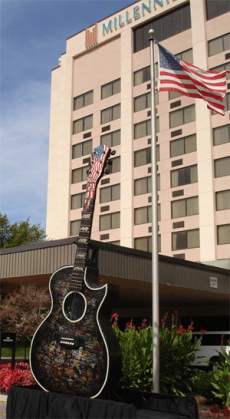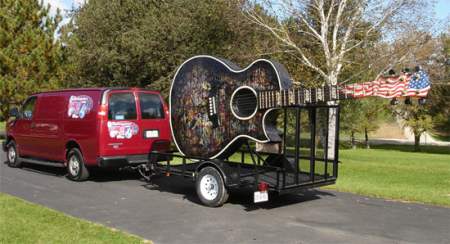This is the story of a Tall Traveling Taylor designed, constructed and painted by Paul Chase.
It all began when... Someone at the Millennium Maxwell House Hotel in Nashville casually mentioned that they would love a big guitar sculpture by Paul Chase to display. I pondered the possibilities for several months. Every time I stayed at the Millennium I would "visualize" the guitar. I took pictures of where it would find it's home. I talked with my friend Wayne the master woodworker. The many considerations included size, materials, weight, waterproofness, the stand, mobility, etc.

A few more months passed by. It was always in the back of my mind, and I was always "playing" with the final "look!"
Another visit with Wayne and he said, "Build it light and cover it with fiberglass." That clicked.
I have several guitars... don't we all? I have two with a Florentine cutaway. They are my favorite for the body design and aesthetic appeal. I am, after all, an artist first and a guitarist second. Ouch, did I say that?
I knew I would have to transport the guitar to various places. I live 600 miles north of Nashville, Tennessee. I had a 6x10 enclosed trailer. I could make it with a removable neck... just like a real guitar. Eventually I knew it had to be all put together and "road worthy" for lots of "show and tell" guitar shows and festivals. Plus, just driving it around Nashville and other places just watching the reaction of the viewers would be a blast. I decided to use my Taylor Doyle Dykes Signature Model for the specs. I wanted it as big as I could get it out of an eight foot sheet of quarter inch mahogany paneling. Bookmatch two sheets for the front and two for the back. Jig saw to specifications. 1x2" bracing for the sides and some 2x4" bracing for the front and back. Jig saw to specifications. Not much hand carving on the bracing. Bending the sides was a challenge. For the extreme bends of the cutaway I used one eight inch masonite.

I did not use a micrometer so some "artistic license" is in play all the way through the final piece of art.
I also needed to beef up some interior "stand supports" for the guitar stand. We guitarists know the danger of the guitar falling off the stand... especially a 300 lb. 16 foot tall guitar.
The neck/fret board is half inch plywood and the head is a composite of a front and back half inch plywood and Styrofoam filler to get the correct proportions. The frets are slices of pine, "fudged" just for looks even though placed at the approximate correct locations. The back of the neck is sculptured with plywood braces and wire fence shaped like the sweet curve of an easy action guitar neck. Don't get out the measuring sticks, remember the artistic license deal.
I carefully hand cut and jig sawed the broomstick posts of the tuners and spent way too much time on the details of the nuts and washers that disappeared under the strings and several layers of fiberglass. The tuning knobs are carved from Styrofoam and the machines are constructed from PVC pluming pipes... don't tell anyone!
The saddle is carved from Styrofoam and the pins were first pingpong balls... oops too big, saw them off. I found a more suitable size oak ball at the hobby store.
Ok, now just cover it with fiberglass! Yeah, just! That was a labor of love. And little fiberglass ichy things all over the house for a month. I wore a vapor proof mask while I listened to guitar music and the sound of sanding, grinding and sawing. Work a little and go for a ride on the Harley to get some air. I would invest a few hours a day for two months. Sometime less, sometime more. Put on a coat of fiberglass or paint and let it dry for a day.
Once completely covered with fiberglass sheeting and resin I decided to really make it "sculptured" and applied heavy texture of bondo... like 6-7 gallons.
Ready for several coats of black enamel paint. Then the collage of my graphicguitars images. Hundreds of subtle guitar fine art paintings and design for an "up close" appeal to the finished sculpture. Both the back and front are covered with prints. I then air painted a burst effect and the sculpture grain effect. The sides are painted with "tone shift" paint that changes color from blue to magenta as you walk around. Fading toward the bottom. Subtle music notes are "floating" from black to the "tone shift" colors.
The sound hole is surround by a circle of white enamel impregnated with glass beads to "blast" under lights at night. Also a one inch white glass bead strip around the edge of the front of the guitar.
The headstock is painted after one of my originals - The "USAguitar" which is now on display in the Country Music Hall of Fame in Nashville, TN. The stars are white enamel with the glowing glass beads.
The markers on the fret board are waving sheet of music notes... white enamel and glass beads.
The entire sculpture is covered in three coats of exterior UV inhibiting clear coat.
The stand is about nine feet tall. I had to design it to pivot or it would be difficult to transport with a 20 foot tall guitar(with trailer). Oh yeah, the strings are steel rods 12 feet long. Lower E and A are one fourth inch steel rod. D and G are 3 sixteenths. And B and E are the light strings at one eighth.
Unfortunately it does not hold tune as well as I like! But it looks great.
For more exciting pictures and other guitar projects check Paul's website.
Paul Chase has been playing the guitar for over 20 years, and has been an artist forever.
He has a bachelors degree in Art, a Masters degree in Education/Communication, he's been a freelance illustrator for years, and he's currently a commercial art/photography instructor in a vocational/technical center.